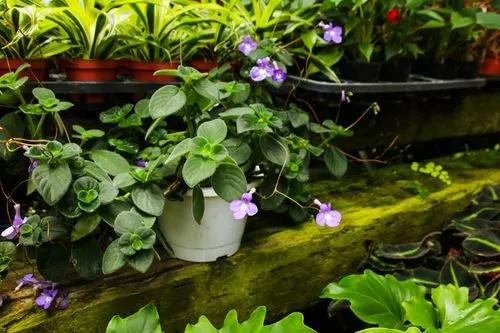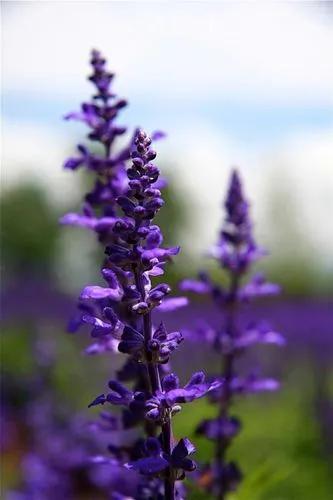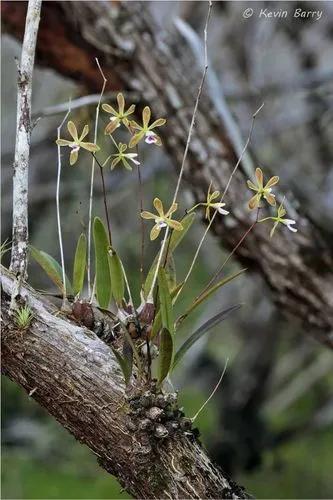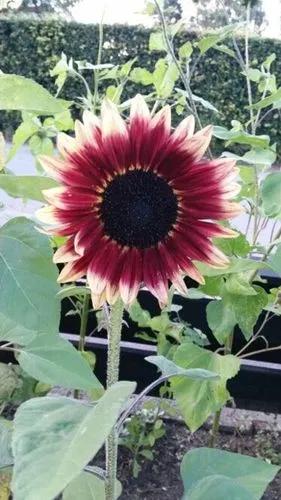Miltonia are comparatively medium large orchid plants reaching about fifty centimeters height. They present subcaespitous growth, that means their pseudobulbs are not tightly packed but slightly spaced by a rhizome, that is longer than on caespitous plants, with length between two and five centimeters. Their roots grow along the rhizome in high numbers. They are white, comparatively thin, usually short and hardly branched. The rhizome is covered by dried imbricating steaths which get increasingly larger at the base of pseudobulb becoming articulated foliar steaths that partially cover them. The pseudobulbs and leaves vary in color from yellowish bright light green to olive green depending on the species and to the amount of sunlight they are exposed to. They may be more oval and laterally highly flattened to slightly tetragonal and elongated and almost always bear two apical leaves. The leaves are narrow, flexible and hardly larger than three centimeters wide and forty long with the apexes rounded sometimes slightly pointed. Some species are about half of this size. The inflorescences are one or two per pseudobulb, shoot from their bases behind the protecting steaths. They are erect and never branched, often longer than the leaves, bearing from one to twelve moderately spaced flowers that open at the same time or in succession holding three or four opened all the time, when the older fades a new one opens. The older flowers of species with white lips that open in succession usually get yellower about the time the next flower opens although they still last one more week before fading. The first to bloom is M. cuneata, during late winter, but the majority of species bloom from late spring to late summer. The flowers of Miltonia vary from four to fifteen centimeters across; the larger are the ones with fewer flowers. Their colors vary from entirely white and pink to dark purple, pale yellow or lilac when plain, or they may highly spotted but then usually they are greenish or brownish with a contrasting labellum often white with purple dots, stains or veins close to the base. The petals and sepals shapes are highly variable from species to species but always somewhat similar to each other within a species. They may be erect and flat or sometimes less open. The labellum is simple or very slightly lobed, usually very wide and showy without salient calli although normally showing more or less subtle keeled thickenings close to the base, usually of different colors; it is much larger and wider than the other segments, often flat but in M. candida embraces the column and in all species it is slightly fused to the column at their bases. The short column does not have a foot and presents two lateral auricles sometimes merged to each other through a fringe that surrounds the superior edge of the clinandrium. The anther is apical and bears two yellow hard pollinia. They possibly are pollinated by bees.
Miltonia Flavescens Care
Miltonia Flavescens



How to Care for the Plant

Water

These plants should often be watered during active growth from spring to autumn, but they should not be allowed to dry out completely between watering. After the flowering in autumn, the amount of water should be gradually reduced.

Fertilizer

During the active growth of the plants should be fertilized every week 1/4-1/2 of the recommended dose of fertilizer for orchids.

Sunlight

Miltonia flavescens needs a light level of 20000-25000 lux.

Temperature

The average temperature of the summer day is 24-26 ° C, night 18 ° C, giving a daily difference of 6-8 ° C. The average temperature of the winter day is 20-21 ° C, the night 13-14 ° C, giving a daily difference of 7 ° C.

Container

These plants are generally grown in pots. A loose, fast-drying substrate is required.

Popularity

6 people already have this plant 2 people have added this plant to their wishlists
Discover more plants with the list below
Popular articles






